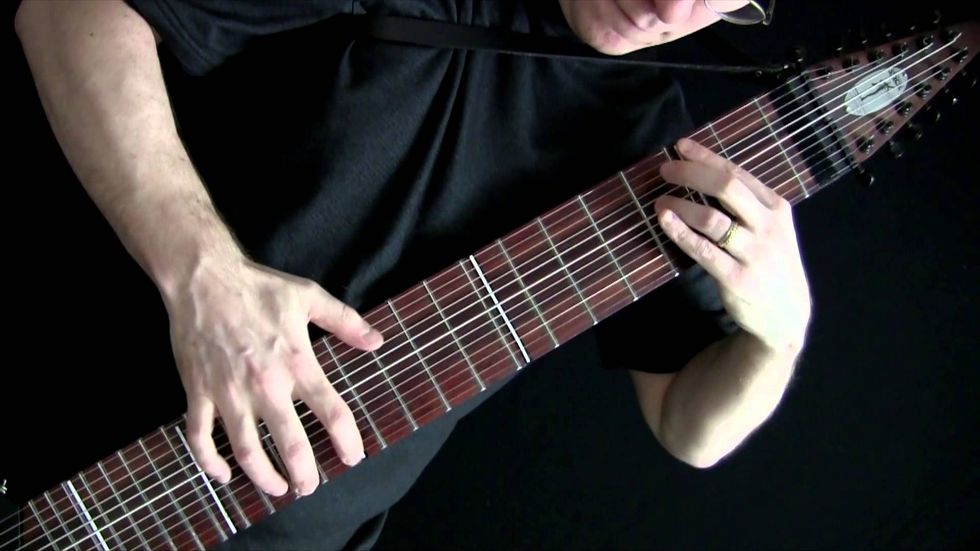When I was in fourth grade, I went to an Art & Wine Festival in Palo Alto, California. On one of the street corners closer to the center of the event was a guy with gray hair sheltering under an umbrella playing what looked to be a long guitar neck minus the body. What caught my eye the most though, was that he was playing not by strumming, but by tapping. It was as if the instrument were an upright hybrid of a drum and a guitar. My dad noticed my sudden interest in it and explained to me that it was called the Chapman Stick.
What is it? The Chapman Stick is an instrument invented in the 70's by Emmett Chapman and is an upright string instrument similar in structure to the neck of a guitar, but fundamentally different in almost every way.
First, the Stick consists of 10 or 12 strings, while a guitar normally only has 6 (no, twelve-string guitars don't count, the extra strings are usually just octaves or unisons). These strings are divided in half on either side, into bass and melody sides. On each side, the strings ascend in tuning from the center two strings, with the bass side tuned to ascending fifths and the melody to ascending fourths. This is what sets it apart from guitars the most, which is tuned from the lowest string upwards by perfect fourths, except for the higher two strings, which are separated by a major third interval.
What does this mean? For starters, ever wonder why you have to learn dozens of chord shapes on the guitar? It's because of those last two strings; the way the guitar is tuned makes it impossible for basic chords in the same family (major, minor, etc) to be shaped in similar ways. This is what the Chapman Stick fixes. Because the intervals between strings on each side of the instrument are the same, this means that, no matter what, each type of chord has its own distinct shape that does not change based on its position on the fretboard.
For example: on a guitar, to switch from a C Major to a G Major chord, you would have to move your ring finger from the fifth to first string, middle finger from fourth to sixth, and index finger from second to fifth. On the Stick, the shape stays the same, you just have to move it one string over. It was designed mathematically to make playing easier for the player.
What else can it do? The Stick is played by tapping out notes onto the strings in between frets, like a guitar. By eliminating the need to strum, the world is opening to not just one hand, but both of them. The left hand can be pounding out a smooth walking bassline while the right hand can be improvising on a blues scale. It also provides the opportunity to play additional musical parts, such as percussion, in addition to bass and melody. Due to the lack of an acoustic body, the entire instrument is electric, with each side of strings being picked up separate from the other (think of it as having two electric guitars that you can apply effects to separately, but be able to play together at the same time). A skilled Stickist is able to emulate multiple instruments at once this way.
Some famous artists who have used the Chapman Stick include: The Blue Man Group, Tony Levin, Nick Beggs, and Bob Culbertson
Why is it significant? The Chapman Stick has the potential to revolutionize the way we play music. Breaking away from traditional playing methods, and being able to fit into almost any music genre, it unlocks an infinite amount of possibilities that we musicians have yet to tap into. Three generations of players have been born since its creation, and it has yet to hit the mainstream music of today.
I continued going to the Palo Alto Art & Wine Festival every year since I first saw Bob playing. Eight years later, I finally got a Stick of my own. Since there's such a lack of players, I've been taking lessons via Skype for the past year. I'm getting there, but it's my hope to bring more attention to this wonderful instrument and to help usher in a new generation of musicians, a generation that will effectively change the way we view music and create even more instruments to experiment and shape the way play today.
Here's a little video of my progress below:
And you thought the Spring Awakening posts were over
A post shared by Bryce(ratops) Stephens (@bman324) on




 Energetic dance performance under the spotlight.
Energetic dance performance under the spotlight. Taylor Swift in a purple coat, captivating the crowd on stage.
Taylor Swift in a purple coat, captivating the crowd on stage. Taylor Swift shines on stage in a sparkling outfit and boots.
Taylor Swift shines on stage in a sparkling outfit and boots. Taylor Swift and Phoebe Bridgers sharing a joyful duet on stage.
Taylor Swift and Phoebe Bridgers sharing a joyful duet on stage.












